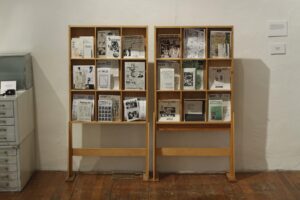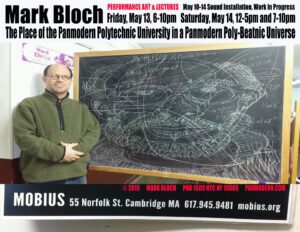The Once and Future DIY Network
by Mark Bloch
Forty-five years ago, I was flailing about in my last year toward a studio art degree at a state university in the midwestern United States thinking “There must be more to art than this.” Thankfully, I was right.
The answer partially arrived courtesy of an artist in residence, the video and performance artist Joan Jonas who became my “drawing” teacher for a semester. She let me know what was happening on the art scene in New York at the time, causing me to switch my major to broadcasting, called telecommunications then, and stop messing around with art. But I was eventually called back into it when I moved to California, and started reaching out to friends around the world, eventually discovering postal art or correspondence art. I found a whole DIY School out there. In those days it was just starting to be called the international mail art network. Eventually it morphed into the Internet.
You can look up mail art on your own. Ray Johnson and his New York Correspondence School started it in the 1950s and Filippo Marinetti and the Italian Futurists did it before Ray. But for me, in 1978, before the Internet, the mail art network was creating social networking and when I couldn’t get a job at as a studio assistant or at an art magazine or as a museum guard or gopher in an art gallery, or even in broadcasting, in which I now held a degree, here was a way to get my work shown for free and to other artists. There were little magazines, publishers of poetry, places to send videos and audio recordings (Yes, it was the golden age of cassette tapes which I still have a lot of if you want one). In this new world, there were people ready to publish me, promote my work, and send me theirs, no questions asked.
When the early Internet came along about ten years later, the same thing happened. It started with text, but it worked its way up to pictures, then audio and now streaming video. There have always been little magazines; some call them vanity projects. But to me the history of self- publishing is one boom town after another waiting to happen. It made me hardly any money but was fun and creative when I needed a public platform for my creativity.
Eventually it did get me into the Museum of Modern Art (MOMA), The Frick, the Getty, the Victoria and Albert Museum (V and A) and elsewhere, but always through the back door. Perhaps you saw “How to Draw a Bunny,” a documentary about Ray Johnson, which has a wonderful sequence about how he got into a Chuck Close portrait show at MOMA with a photocopy sent to the library.
The mail art network, zine network and cassette network didn’t create Do It Yourself culture, but they helped. I traded my work for other people’s stuff. I created an archive. I BECAME an archive. “The mailbox is a museum” we used to say. I countered with a rubber stamp, “The address is the art.” Grunge came along at one point. DIY Record companies in Seattle with which I was in touch with were suddenly recording and putting out bands like the Screaming Trees on cassette after Nirvana became a thing. I’ve since learned there are always underground enterprises being folded into mainstream culture. A magazine called Factsheet Five in the 1980s and 90s reviewed the other zines. As the Internet ramped up, they eventually even started their own BBS (Bulletin Board System) online. Stewart Brand, known for producing the Whole Earth Catalogue, a large format “hippie” publication from the ’60s started the WELL, the Whole Earth ‘Lectronic Link,’ a BBS which I joined in 1989. As one of the first mail artists to enter cyberspace, I can tell you that it was not that different from what I had learned in mail art. The Do-It-Yourself world was expanding—fast.

I am sharing my own experience because each of us is at the center of our own network. The fact is that all the sci fi networking of Factsheet Five and the hippie networking of Brand led to the queer networking, black networking, feminist networking and political networking we know so well today. A big international netWOKE, as Ron DeSantis might call it, has all grown together and thrives.
An American DIY magazine publishing niche in the first half of the twentieth century could be said to be exemplified by Popular Mechanics magazine founded in 1902. After WWII this scaled up into an interest in DIY home improvement and construction projects and splintered into various crafts genres which now support hobby chain stores. Everything from Cold War nuclear fallout shelters to punk fanzines set the stage for what followed electronically. Think CB radios, skateboarding, surfing, gamers, comics, Japanese manga, guerrilla marketing, indie films, and Linux. All of this is part of a larger picture that evolved out of DIY culture. DIY culture came from Stuart Brand’s oversized ‘Whole Earth Catalogue’, subtitled Access to Tools which used basic typesetting and Old School page-layout tools. First appearing in late 1968, it soon after featured a picture of our planet on the cover, an image we take for granted now but back then was being seen for the first time. Perhaps Marshall MacLuhan’s global village idea was as important as anything else.

The “commons” are resources accessible to all members of a society, even when owned privately. Creative Commons is an international nonprofit organization to grow and sustain the thriving commons of shared knowledge and culture. Copyrights and other concepts of ownership are called into question. Examples of digital commons are Wikipedia, free software, open-source hardware projects and open-source magazines.
However, as impossible as it is to isolate the Alternative or Alt culture from the mainstream, cultural studies have classified individual alternative cultures from alternative culture. Individual slivers that exist outside or on the fringes of popular or Pop culture have little or nothing in common besides their relative obscurity with each having the potential to grow into an industry.

Are you greedy or deluded enough to believe it could happen to you? Art students are often pre-programmed to believe that they just might be the second coming of whatever overnight success superstar artist the world happens to be obsessing about right now. Yes, I could be next so get out of my way. But we, like other humans, are also hard-wired to be of assistance. If you ever want to know the true nature of the human race, ask for directions. One of the great reasons NOT to have GPS is that you shouldn’t miss out on this ancient form of altruism. People will fall over themselves to help you if you learn how to ask.
